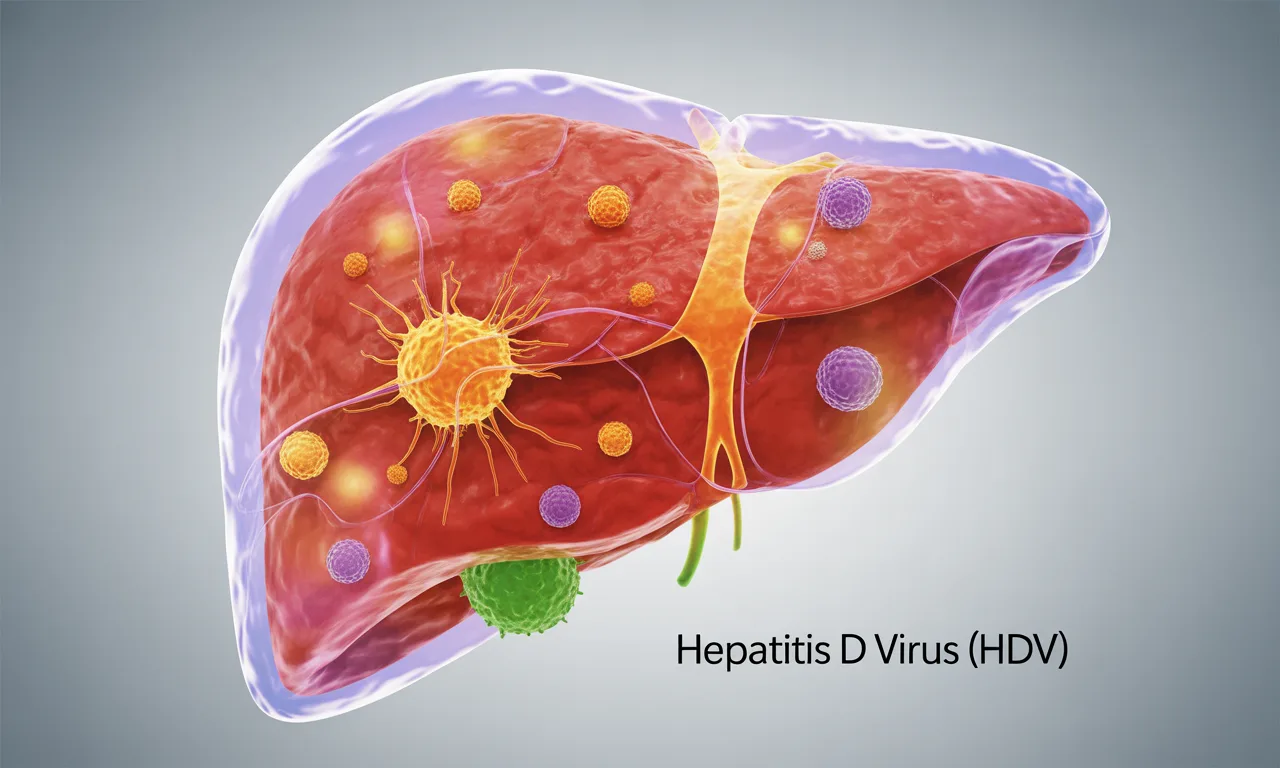What is Hepatitis D?
Hepatitis D, also known as Hepatitis Delta, is a serious liver infection caused by the Hepatitis D virus (HDV). What makes HDV unique is that it only occurs in people who are already infected with Hepatitis B virus (HBV). HDV cannot replicate or cause infection on its own — it requires the HBsAg (Hepatitis B surface antigen) to survive and multiply.
This co-infection (HDV + HBV) leads to more severe liver disease, often accelerating progression to cirrhosis, liver failure, or hepatocellular carcinoma (liver cancer) faster than HBV alone.
Causes and Transmission of Hepatitis D
HDV is transmitted through contact with infected blood or bodily fluids, similar to Hepatitis B. It spreads through:
- Injection drug use (sharing needles or syringes)
- Unprotected sex with an infected person
- Blood transfusions or unsafe medical procedures
- Mother-to-child transmission (less common)
- Sharing personal items like razors or toothbrushes contaminated with blood
HDV can occur as:
- Co-infection: When a person is infected with HBV and HDV at the same time.
- Superinfection: When a person already infected with chronic HBV later acquires HDV. This form is often more severe and likely to cause chronic liver disease.
Symptoms of Hepatitis D
Symptoms of Hepatitis D are often similar to those of Hepatitis B but more intense and rapid in progression. These may include:
- Fatigue and extreme weakness
- Loss of appetite
- Nausea and vomiting
- Abdominal pain (especially in the upper right side)
- Joint and muscle pain
- Jaundice (yellowing of the skin and eyes)
- Dark urine and light-colored stools
- Swelling of abdomen (ascites) in advanced liver disease
Some individuals may remain asymptomatic until liver damage becomes advanced.
🧪 Diagnosis and Testing
Accurate diagnosis of Hepatitis D (HDV) is essential, especially in individuals already diagnosed with Hepatitis B (HBV). Testing helps detect co-infection or superinfection and assess disease progression. Common diagnostic tests include:
- Anti-HDV Antibody Test (IgM):
Detects recent or current infection by identifying HDV-specific IgM antibodies. This test is especially useful in distinguishing between acute and chronic infections. - HDV RNA PCR Test :
Confirms active viral replication by detecting HDV RNA in the blood. This is the most definitive test for current infection and is also used to monitor treatment response. - HBsAg (Hepatitis B surface antigen):
Must be positive for HDV infection to exist, as HDV depends on HBV for replication. - HBV DNA Quantitative Test:
Helps determine HBV viral load and co-manage treatment with HDV. (Normal Range) - Liver Function Tests (LFTs):
Assess liver inflammation, enzyme levels (ALT, AST), and liver function. - Liver Fibrosis Assessment (FibroScan or biopsy):
Used in chronic cases to measure liver scarring or cirrhosis severity.
Early detection through these tests allows clinicians to initiate timely treatment and reduce the risk of severe liver damage or complications.
Prevention of Hepatitis D
There is no vaccine for Hepatitis D, but it can be prevented by getting vaccinated against Hepatitis B, since HDV requires HBV to survive.
Prevention methods include:
- Hepatitis B vaccination (offers indirect protection against HDV)
- Avoiding shared needles, syringes, or blood-contaminated items
- Safe sex practices to reduce risk of transmission
- Screening blood and organ donors
- Educating HBV-infected individuals on the risks of HDV superinfection
Public health measures that control HBV will automatically reduce HDV transmission.
Treatment and Prognosis
Treatment of Hepatitis D is challenging and still evolving. The goal is to suppress HDV replication and prevent liver damage.
- Pegylated Interferon-alpha (Peg-IFN-α): The only widely accepted treatment, effective in some patients. Long-term therapy may be required.
- Antiviral therapy for HBV (e.g., Tenofovir, Entecavir): Often used in co-management but does not directly affect HDV.
- Bulevirtide (HDV entry inhibitor): Approved in the EU and in trials in other countries, showing promising results.
- Liver transplantation: May be necessary in patients with end-stage liver disease or liver cancer due to HDV.
Regular monitoring of HDV RNA levels, liver function, and HBV status is essential for managing chronic Hepatitis D.
Importance of Awareness and Screening
Due to its dependence on HBV and its potential for rapid liver damage, screening for HDV is essential in all individuals diagnosed with chronic Hepatitis B.
Key groups who should be screened include:
- People with chronic HBV who show signs of liver damage
- Individuals from regions where HDV is common (Asia, Africa, Eastern Europe)
- People who inject drugs
- People living with HIV and HBV co-infection
Public awareness, timely screening, and preventive vaccination are crucial in reducing the global burden of Hepatitis D.
Conclusion
Hepatitis D is a serious and aggressive liver infection that only affects those already infected with Hepatitis B. While no vaccine exists for HDV itself, preventing Hepatitis B through vaccination offers the best protection. With emerging treatments and improved diagnostics, managing HDV is increasingly possible — but early detection remains the key to saving lives.



